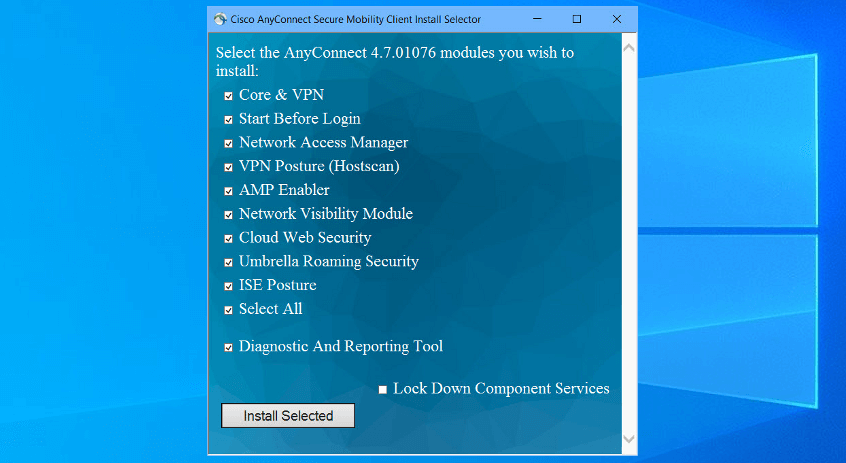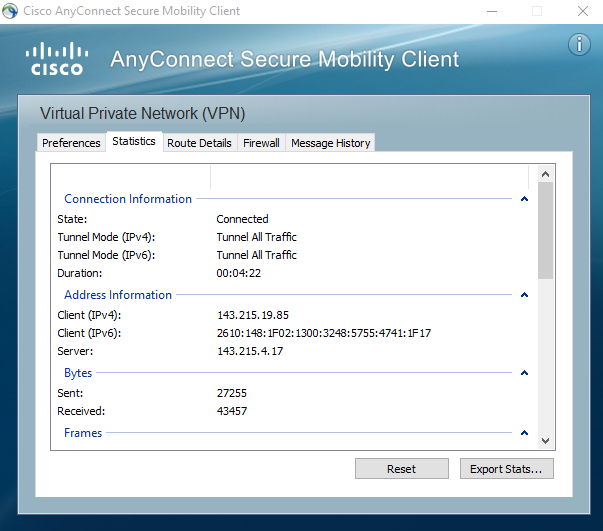The Cisco AnyConnect Secure Mobility Client web deployment package should be downloaded to the local desktop from which the ASDM access to the ASA is present. In order to download the client package, refer to the Cisco AnyConnect Secure Mobility Client web page. Cisco AnyConnect Secure Mobility Client 4.9.03047 Cisco AnyConnect Secure Mobility Client – Let your employees connect and work with your network from anywhere in the world with high security. The most important thing is to be able to connect from anywhere with acceptable security, and in fact, after connecting, they will not be different.
Cisco AnyConnect Secure Mobility Client (formerly Cisco AnyConnect VPN Client) provides endpoint security, policy enforcement, and encrypted network connectivity for a variety of platforms to allow corporate network access. This entry only covers the Desktop Edition of this technology. See Category tab/Comparable for the corresponding Mobile entry.
Table of Contents

Some USC online-based services require access through on-campus USC Secure Wireless or a wired network connection. USC offers a Virtual Private Network (VPN) connection to provide secure remote access to these services when you are off-campus. When off-campus, you must use the Cisco AnyConnect VPN client to access internal USC systems handling confidential or sensitive data, such as Student Information System (SIS), and file servers for specific schools and departments. The Cisco AnyConnect Secure Mobility client is a web-based VPN client that does not require user configuration.

This webpage provides instructions on how to install and connect to the Cisco AnyConnect Secure Mobility client for Windows 10 operating systems, including both 32- and 64-bit versions.
Login and Download VPN Software
- Connect to your local network.
- Go to https://vpn.usc.edu/.
- On the login screen, enter your USC NetID and Password.
- Click Login.


- After you have logged in, click AnyConnect on the left.
- In the middle of the screen, click Start AnyConnect.
- On the following Download & Install screen, click the Download for Windows button. You may be prompted to save the file, or it may automatically download to your Downloads folder.

Install AnyConnect VPN Client
Cisco Anyconnect Secure Mobility Client Mac
- Search for the downloaded file on your computer and double-click it.
- You may see the file in the bottom left-hand corner of your screen.
- If you do not see it there, look in your Downloads folder.
- A Cisco AnyConnect Secure Mobility Client Setup pop-up window appears. Click Next. This will initiate the installation.
- On the End User License Agreement window, select I accept the terms in the License Agreement.
- Then click Next.
- Click Install. The installation will begin.
- If prompted to allow the installation, click Yes.
- If prompted, enter your computer’s Admin ID and password. This is the ID and password you use to log into the computer.
- When the installation is complete, click Finish.
Connect with AnyConnect VPN
- Search for the Cisco AnyConnect Secure Mobility Client app on your desktop (Type “Cisco AnyConnect” in your computer search bar OR select the Windows Start button and search in the menu items).
- Click to open the application.
- In the VPN pop-up window, enter: vpn.usc.edu
- Then click Connect.
- On the Welcome screen enter your USC NetID and Password.
- Click Sign in.
- On the Please verify your identity screen, click on Send Me a Push, Call Me, or Enter a Passcode to complete the Duo Two-Factor Authentication (2FA) process.
- You are now connected to the USC network through the Cisco AnyConnect VPN client.
Getting Help
If you need help installing or connecting to your Cisco AnyConnect Secure Mobility client, contact the ITS Customer Support Center.
I enjoy the new VPN client, it’s small and fast, however I hated that you can’t save profiles in the drop down list like you could in the traditional VPN client.
Cisco Anyconnect Connect Secure Mobility Client
This has been bothering for a long time and kept finding conflicting information on if this was possible or not. Finally got it to work.
Latest Cisco Anyconnect Client
This is for version 3.1x and Windows 7 let me know if this works for your version and OS.
- Create a preferences.xml file in C:ProgramDataCiscoCisco AnyConnect Secure Mobility ClientProfile
- Use this format
<?xml version='1.0' encoding='UTF-8'?>
Cisco Connect Mobility Client
<AnyConnectProfile xmlns='http://schemas.xmlsoap.org/encoding/'>
<ServerList>
<HostEntry>
<User>dclouduser</User>
<SecondUser></SecondUser>
<ClientCertificateThumbprint></ClientCertificateThumbprint>
<ServerCertificateThumbprint></ServerCertificateThumbprint>
<HostName>dCloud</HostName>
<HostAddress>dcloud-rtp-anyconnect.cisco.com</HostAddress>
<Domain></Domain>
<Group>ssl_url</Group>
<ProxyHost></ProxyHost>
<ProxyPort></ProxyPort>
<SDITokenType>none</SDITokenType>
<ControllablePreferences>
<LocalLanAccess>true</LocalLanAccess></ControllablePreferences>
</HostEntry>
<HostEntry>
<User>dmacias</User>
<SecondUser></SecondUser>
<ClientCertificateThumbprint></ClientCertificateThumbprint>
<ServerCertificateThumbprint></ServerCertificateThumbprint>
<HostName>Speech-Soft</HostName>
<HostAddress>vpn.dmacias.com</HostAddress>
<Domain></Domain>
<Group>ssl_url</Group>
<ProxyHost></ProxyHost>
<ProxyPort></ProxyPort>
<SDITokenType>none</SDITokenType>
<ControllablePreferences>
<LocalLanAccess>true</LocalLanAccess></ControllablePreferences>
</HostEntry>
</ServerList>
</AnyConnectProfile>
- Save the file.
- Restart the connectivity client.
- Enjoy
Cisco Anyconnect Mobility Client Download 4.5
~david
EDIT 01/18/2017: This also works with Cisco AnyConnect 4.x!
